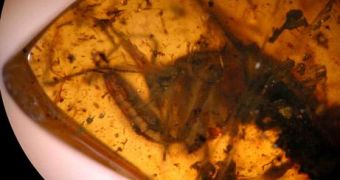These insects are better known for their specific hunting technique, for using their forelegs in order to maintain a "praying" posture in the stalk and for the cannibalistic habits of the female during mating. The praying mantises are known to be related to cockroaches, stick insects and termites. A new 87-million-year-old Japanese praying mantis discovered encased in amber could explain more about the evolution of these odd insects from the Cretaceous period to modern times (and current types).
The newly discovered fossil, encountered in January at a depth of 6.5 ft (2 m), underground in an amber mine in Iwate Prefecture (northeastern Japan) is 0.56 in (1.4 cm) long from its antennae to the tip of its abdomen. Its forelegs, head, and antennae are well preserved, but the wings and abdomen have been damaged.
"This part of Japan is famous for producing large amounts of amber, but it was very fortunate for me to find this specimen. I found it in a deposit that had lots of other insects-ancient flies, bees, and cockroaches-but this was the only praying mantis," Kazuhisa Sasaki, director of the Kuji Amber Museum and discoverer of the fossil told National Geographic News.
"The mantis is the oldest ever found in Japan and one of only seven in the world from the Cretaceous period. Previous mantis specimens have been found in New Jersey, northern Myanmar (Burma), Siberia, and Lebanon," said Kyoichiro Ueda, executive curator of the Kitakyushu Museum of Natural History and Human History.
With all that, the new fossil comes with many interesting data about the evolution of the mantises.
"Modern mantises have a series of spines - maybe five or six - on their forelegs, to help them catch prey. The American Museum of Natural History has told us that no mantis from the Cretaceous period has ever been found with spines, but the new specimen has two such spines protruding from its femur," said Ueda.
Also, unlike the other Cretaceous mantises, this new fossil insect displays tiny hairs on its forelegs.
"The block of amber is being polished to give researchers a better view of different parts of the fossil, which may reveal other differences between ancient and modern mantises. The years of the late Cretaceous period were a kind of transition phase between the ancient and modern worlds, and this fossil displays many intermediate elements between the two eras. It is an excellent example of the transformation of morphological structures," Ueda explained.

 14 DAY TRIAL //
14 DAY TRIAL //